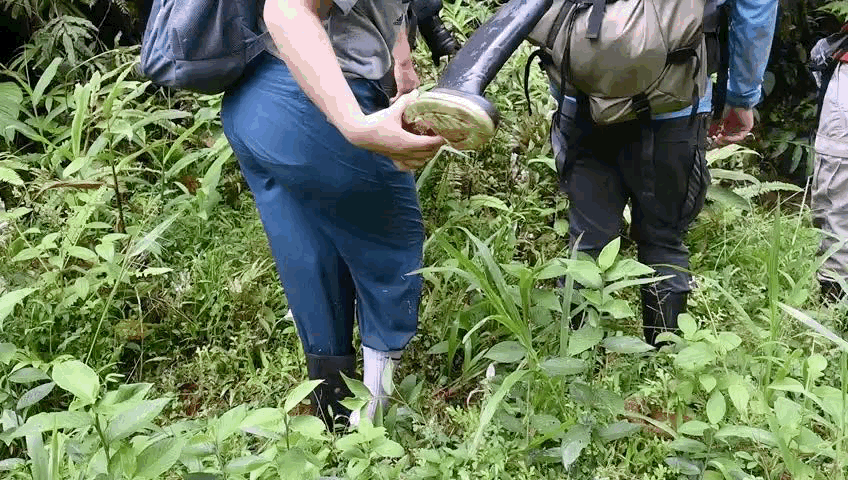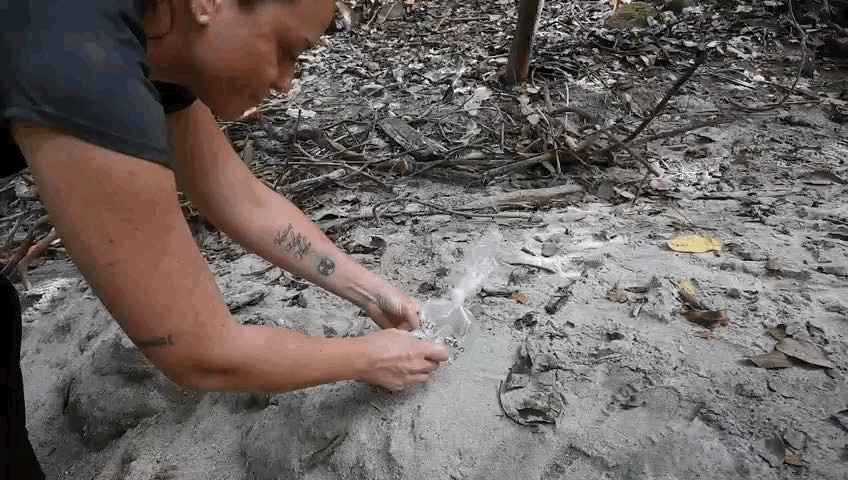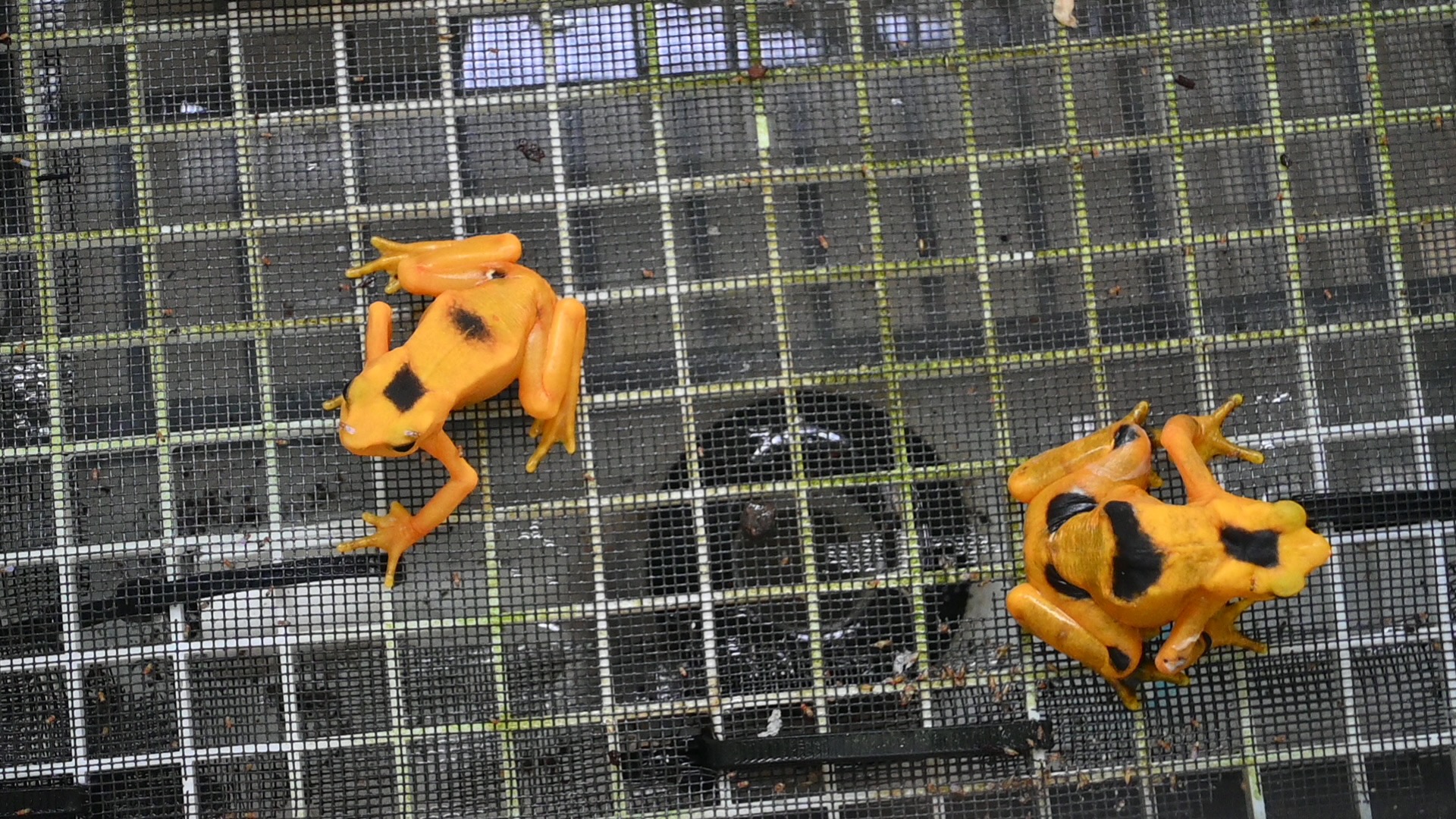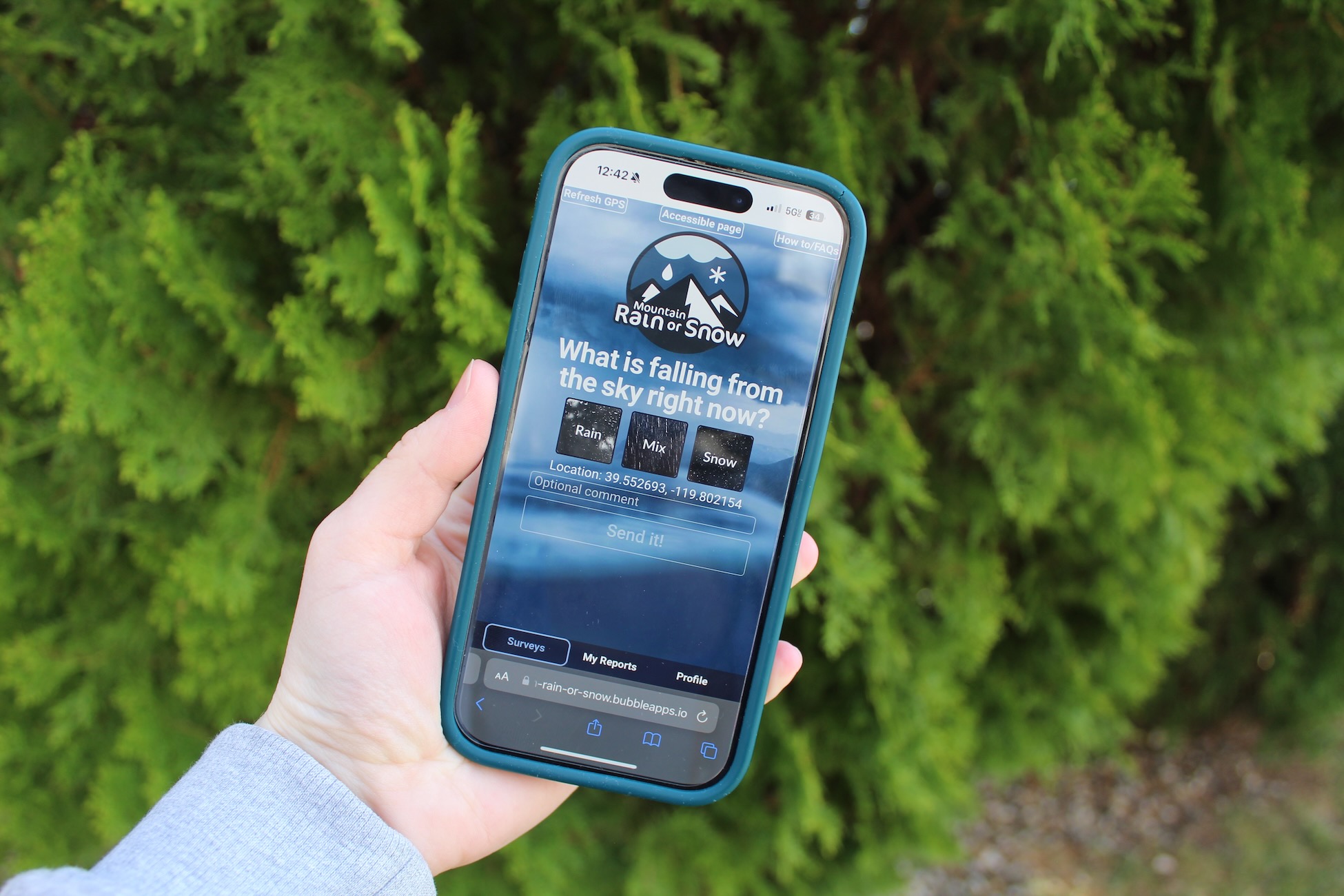In August 2023, Hitchcock Project reporter Vanesa de la Cruz Pavas traveled to Panama with a team of researchers from UNR’s College of Science who have been studying Panamanian golden frogs (photographed above). This story was originally published as part of a StoryMap titled University of Nevada, Reno in Panamá, produced in collaboration with Michelle Werdann of the College of Science.
A giant hand holding a plastic bag appears in the sky. With fist almost closed, it lunges at the ground, trying to catch something, but fails. Once again, the hand jumps from side to side, trying to catch the frog, which is faster. Again, it fails. There is more leaping, more moving plastic, more speeding, and finally, inside the closed fist, the frog is caught. The giant hand ties the bag and places it inside a backpack.

With hand enclosed in plastic bag, a scientist gently catches a frog at a field site in El Valle de Antón, Panama. Credit: Vanesa de la Cruz Pavas.
El Valle de Antón, in Panama, is not only a picturesque town located in the crater of an extinct volcano in the Panamanian highlands, but is it also, from my journalistic perspective, a perfect place for biological research, with its cooler temperatures, its mountains, waterfalls, its biodiversity, and the cloud forests.
Researchers from the University of Nevada, Reno seem to think so, too, as a team of women scientists consisting of two postdocs, one college student, two high school students, and two journalists embarked last August on a trip from Reno to El Valle, a 2-hour drive from Panama City.
The reason for the trip is one of tragedy and hope: there is a highly lethal disease called chytridiomycosis that has been devastating for Panamanian amphibian populations, including the iconic Panamanian golden frog (Atelopus varius/zeteki), their beloved national animal. This and other species were rumored to be extinct. However, the University and other research teams found evidence that several amphibian species are persisting, and even recovering, long after the lethal disease outbreaks in the 1990s.
Now the UNR team, led by associate professor Jamie Voyles from the Department of Biology, travels twice a year, during wet and dry transition periods, to Panama to collect samples from the frog skin secretions, as chytridiomycosis is a fungal disease that affects their skin and all its functions. Then, in the laboratory, they conduct experiments to test for changes in the pathogen – a fungus called Batrachochytrium dendrobatidis or Bd – in the frogs. They found that the frogs now have better defenses against the pathogen than before. They are fighting back!
Walking in the wet boots of a scientist
The day started early, at 7 in the morning. We rode up the mountains, on steep slopes, in a 4×4 truck with geckos stuck to the windshield to arrive at each site, some of which were fairly remote. Dressed with rain boots and rain jackets, the scientists carried all their research equipment in waterproof backpacks.
But the drive was the easy part. It then took a memorized hike in the forest, dodging barbed wire and fallen trees and walking in zigzags from one side of the river to the other, sometimes losing sight of the other crew members due to the fog, to finally arrive at the transects. I stopped several times to empty the water that kept filling my borrowed rain boots.

A member of the research team empties water from her boots during a wet field day in Panama. Credit: Vanesa de la Cruz Pavas.
At each site, the researchers take a moment to collect biological data, such as water and air temperature, humidity, and water pH, before they try catching the frogs, explained Carolina Lambertini, postdoctoral associate in the UNR Department of Biology.
Then, the search begins. They have three focal frog species: the Panamanian common rocket frog (Colostethus panamansis), Warszewitsch’s frog (Lithobates warszewitschii), and the Panamanian golden frog (Atelopus varius/zeteki). But they also catch and sample other species if they find them, to see if they can detect the pathogen.
Walking up the stream, they caught the two first species — rocket frogs and and Warszewitsch’s frogs — and a salamander, but could not find any golden frog. Researchers haven’t found any golden frogs in these transects since 2012-2013. Some frogs were harder to catch than others. The rocket frog is faster and harder to catch and leaped from the hands to the t-shirts of the researchers.
Once a frog has been captured, data collection begins. They take the frog’s body temperature and the surface temperature.
“We then try to catch them using plastic bags, to avoid contamination, and once in the bag we get their body temperature, the time of the catch, and at what part of the transect they were collected; we also write if they were in a rock, moss, or so on,” explained Maria Delia Basanta, the other UNR postdoctoral associate who traveled with us.
At the end of each transect, the researchers sit in a circle on the river bank and start the sampling process in the field. While inside the bag, frogs are weighed and measured with the Snout-Ventral Length, or SVL, a measurement taken from the tip of the frog’s snout to the cloaca – the opening for the digestive and reproductive tracts.
“With gloves, we take the frog from the bag, and with a swab, we follow a sterilized protocol that consists of swabbing the legs five times, the feet five times, hands five times, and 10 on the belly,” Basanta said.
During the swabbing process, some frogs stay quiet, some play dead, and others like to stretch, showing off their long legs. The researchers take notes on all the characteristics, and once all the frogs have been sampled, they are released back into the transect while the team walks back down the stream.

A researcher uses a Q-tip to swab a Panamanian frog for signs of the pathogen Batrachochytrium dendrobatidis. Credit: Vanesa de la Cruz Pavas.
“The idea with the swabbing is to detect this pathogen,” Bastanta explained. “Then, at the lab, we study how the frogs are affected, and try to understand how the amphibian communities are prevailing.”
After releasing the frogs, the crew finds a different location to have lunch, chat about their findings, and prepare for the rest of the day, which sometimes consisted of doing some sample processing at home, and sometimes included projects with the community. Basanta dressed several times as a bright yellow golden frog to teach kids and teenagers at the local schools about the importance of these amphibians and the protection of the ecosystems.
Ongoing research
Some of the lab work is done at The Smithsonian Conservation Biology Institute’s Center for Species Survival and El Valle Amphibian Conservation Center in Panama. It is also done by students and researchers back at UNR.
Lambertini is researching the role of the frogs’ skin secretions as an immune response against the infection, and Basanta is trying to see if genetic changes are happening in the amphibians in comparison with the samples taken before the pathogen arrived.
Voyles, who didn’t travel this time to El Valle, explained that what they have found is that frogs now seem to have better defenses against the same pathogen.
“We have learned that it’s not the pathogen that has changed in this system, but rather that the amphibian seemed to be fighting back with their defenses, their immune systems,” she explained.
They are trying to understand how this process is happening for different species because they all have slightly different immune responses to the infection.
“Some species are doing well,” Voyles said. “The species called Lithobates warszewitschii is recovering much better than many of the other species in the area, particularly compared to the golden frog, which is still present but it’s very hard to find. So we want to understand the difference between these two species. Why has one recovered so well and the other one is still struggling to recover from this disease outbreak?”
The grant that Voyles’s team currently has will continue for two more years, but they hope to find more opportunities to keep doing research.
“It is really important to understand why these species have gone missing, and how we can facilitate their recoveries,” Voyles said. “From another perspective, as we know from the recent COVID pandemic, there’s a lot that scientists don’t understand about infectious diseases, so this research is also useful.”
Back to El Valle de Antón, with the India Dormida mountain, a profile that resembles a sleeping indigenous woman, as the background, groups of people celebrated last August 14, the Golden Frog Day with a week of activities that included collecting trash from the streets, science fairs with students, and a lot of dancing.

At the end of the sample collection, a researcher releases a frog back into the wild. Credit: Vanesa de la Cruz Pavas.
Vanesa de la Cruz Pavas is a science communication specialist for the Hitchcock Project and graduated from the Reynolds School of Journalism’s Media Innovation master’s degree program during December 2023. View a StoryMap about this project at https://arcg.is/bSerT!






